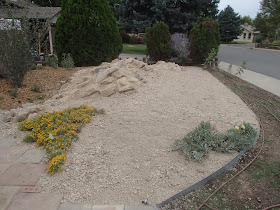This March, an old pet plant of mine finally did its trick.
I've got a small corpseflower or voodoo lily, Amorphophallus konjac, which is sister to Amorphopahllus titanum, which is famously the world's largest flower. Both put up a fine stink when they bloom. Native to Borneo and Southeast Asia respectively, they are a clan of plants which attract flies for pollination. As a plant, they are giant corms (bulbs) which produce one massive leaf per year in the summer, and occasionally bloom in late winter with a single, stinking bloom, which is essentially built of of a wrinkly pike wrapped in a single wrinkly giant petal. No wonder it inspired such perverted scientific names.
There it stands today, in a ten gallon pot, towering over all the baby plants in the nursery. And by its side is a youth of the king-daddy species, A. titanum, who is putting out a nice new leaf right now.
I've been growing the bulb, which is now the size of a volleyball, since 2011. It unfurls its great leaf every summer outside and sleeps dry and quietly indoors in a bucket under my desk all winter. Until late last winter.


I've got a small corpseflower or voodoo lily, Amorphophallus konjac, which is sister to Amorphopahllus titanum, which is famously the world's largest flower. Both put up a fine stink when they bloom. Native to Borneo and Southeast Asia respectively, they are a clan of plants which attract flies for pollination. As a plant, they are giant corms (bulbs) which produce one massive leaf per year in the summer, and occasionally bloom in late winter with a single, stinking bloom, which is essentially built of of a wrinkly pike wrapped in a single wrinkly giant petal. No wonder it inspired such perverted scientific names.
There it stands today, in a ten gallon pot, towering over all the baby plants in the nursery. And by its side is a youth of the king-daddy species, A. titanum, who is putting out a nice new leaf right now.
I've been growing the bulb, which is now the size of a volleyball, since 2011. It unfurls its great leaf every summer outside and sleeps dry and quietly indoors in a bucket under my desk all winter. Until late last winter.
I sent an email invitation out literally a day or two before it opened for a spontaneous wine & cheese and nasty plant party, not really knowing what its schedule would be. It turned out to be a very fun little party. A lot of plant friends, especially from the cactus club, and dogs came over.
There was indeed an elusive-to-describe but ever-present odour in the air which one would immediately notice coming in the door, and was capable of gagging a person who took a sniff within a foot of the flower itself. Someone brought some stinky cheese which we enjoyed.
But my favourite story is from our friend Ada who surprised me by not only coming, but arrived at the door with two bottles of wine to celebrate an echo of family history, and needed her picture taken with the plant.


For she knew of a family photo from circa 1938 of her grandma Ina and her great-grandmother, in turn, who grew the flower. A glass of wine to toast grandma, 2016!

















